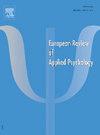儿童爱犬问卷的心理测量特性研究
IF 1.4
4区 心理学
Q3 PSYCHOLOGY, APPLIED
European Review of Applied Psychology-Revue Europeenne De Psychologie Appliquee
Pub Date : 2025-07-01
DOI:10.1016/j.erap.2025.101114
引用次数: 0
摘要
对照顾者的安全依恋在很大程度上被认为是儿童发展的促进者。对成年人的研究表明,他们可能会对宠物狗形成一种全面的依恋,包括依恋关系的四个关键特征(寻求接近、避风港、分离痛苦、安全基础)。目的对《儿童犬依恋问卷》(ADQC)进行验证,该问卷测量了儿童犬依恋的核心维度。方法4 ~ 7岁儿童的家长(n = 433;94.5%为母亲)在线完成ADQC,同时填写评估儿童社会情感发展和父母反思功能的问卷。结果探索性因子分析显示,ADQC有两个因子(邻近寻求/分离困扰、安全基地),且各因子具有较好的内部一致性。ADQC得分与短期宠物依恋量表有较大的相关性,表明具有较好的收敛效度。ADQC与儿童的共情、心理理论和情绪调节之间也存在关联,其中大部分在控制父母反思功能时仍然显着。结论:儿童对宠物狗的强烈依恋可能有助于社会情感的发展,这超出了父母培养这种发展的能力(例如,通过对儿童进行充分的心理化)。本文章由计算机程序翻译,如有差异,请以英文原文为准。
Étude des propriétés psychométriques du Questionnaire d’attachement au chien chez l’enfant
Introduction
Secure attachment to caregivers is largely recognized as a facilitator of child development. Studies among adults suggest that they may form a full-blown attachment to their pet dog, including the four key features of an attachment relationship (seeking proximity, safe haven, separation distress, secure base).
Objective
This study aimed to validate the Attachment to Dog Questionnaire for Children (ADQC), which measures these core dimensions of child-to-dog attachment.
Methods
Parents (n = 433; 94.5% mothers) of four- to seven-year-olds completed online the ADQC, along with questionnaires assessing the child's socio-emotional development, and parental reflective functioning.
Results
Exploratory factor analyses revealed that the ADQC taps two factors (proximity seeking/separation distress, secure base), each showing good internal consistency. The ADQC scores had large correlations with the Short Attachment to Pet Scale, suggesting good convergent validity. Associations were also observed between the ADQC and the child's empathy, theory of mind and emotion regulation, most of which remained significant when controlling for parental reflective functioning.
Conclusion
A strong attachment of the child to his/her pet dog could contribute to socioemotional development, beyond the parent's ability to foster such development (e.g., through adequate mentalization of the child).
求助全文
通过发布文献求助,成功后即可免费获取论文全文。
去求助
来源期刊

European Review of Applied Psychology-Revue Europeenne De Psychologie Appliquee
PSYCHOLOGY, APPLIED-
CiteScore
2.20
自引率
20.00%
发文量
38
期刊介绍:
The aim of the Revue européenne de Psychologie appliquée / European Review of Applied Psychology is to promote high-quality applications of psychology to all areas of specialization, and to foster exchange among researchers and professionals. Its policy is to attract a wide range of contributions, including empirical research, overviews of target issues, case studies, descriptions of instruments for research and diagnosis, and theoretical work related to applied psychology. In all cases, authors will refer to published and verificable facts, whether established in the study being reported or in earlier publications.
 求助内容:
求助内容: 应助结果提醒方式:
应助结果提醒方式:


